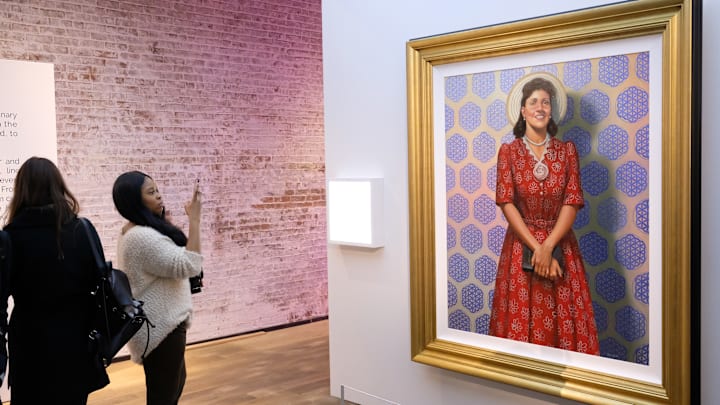Update (August 2, 2023): Members of the Lacks family agreed to a settlement in their lawsuit accusing Thermo Fisher Scientific, a biotech firm, of profiting from the HeLa cell line without compensating Henrietta Lacks’s heirs. The amount of the settlement was not disclosed. The family had also reached an agreement with the National Institutes of Health in 2013 to control some access to the HeLa cells’ DNA. Speaking outside the court where the latest settlement was made, Lacks’s grandson Alfred Lacks Carter, Jr., told the AP, “It was a long fight—over 70 years—and Henrietta Lacks gets her day.”
On February 8, 1951, a surgeon at Johns Hopkins Hospital in Baltimore, Maryland, shaved a piece of cancerous tissue from the cervix of a 30-year-old woman. She had signed an “operation permit,” allowing him to place radium into her cervix to treat her cancer, but nobody had explained their plans to her. And no one foresaw that Henrietta Lacks, a Black woman with a sixth-grade education and five children, would become the mother of modern medicine.
Henrietta was born Loretta Pleasant on August 1, 1920, in Roanoke, Virginia. Somehow, her name became Henrietta. After her mother died in 1924, Henrietta was sent to Clover, Virginia, to live with her grandfather, Tommy Lacks. Her cousin David “Day” Lacks lived in the same house.
Seventeen years later, after having two children together, Henrietta and Day married and then moved close to Baltimore so that Day could work at Bethlehem Steel while Henrietta took care of their growing family. She was big-hearted, fun-loving, and pretty, and though only 5 feet tall, she dressed and walked with a flare.
Immortal Cells
But on January 29, 1951, four months after the birth of her fifth child, Henrietta went to the dreaded hospital. Most Black people living in the Baltimore area did not trust Johns Hopkins. It was segregated, so they were certain they would not receive the same quality of care as white people, and, worse, they would be used for medical experiments. There were rumors that surgeons routinely performed hysterectomies on Black women who came in with any type of abdominal or pelvic pain. Henrietta was not one to complain, but, according to the 2010 book The Immortal Life of Henrietta Lacks by Rebecca Skloot, she could no longer bear the painful “knot on her womb.”
The tissue taken from her cervix 10 days later was given to Dr. George Gey, director of tissue culture research at Hopkins. He believed that if he could find a continually dividing line of malignant human cells, all originating from the same sample, he could find the cause of cancer—and its cure. His assistant placed tiny squares of the specimen into test tubes, then labeled each tube with the first two letters of the unwitting donor’s first and last names: HeLa.

Soon, Henrietta’s cells began to divide. And, unlike the other cells they had sampled, they did not die. Gey started giving the immortal cells to colleagues, saying they had come from a woman named Helen Lane.
Within two years, HeLa cells had been put into mass production, commercialized, and distributed worldwide, becoming central to the development of vaccines and many medical advances. By 2017, HeLa cells had been studied in 142 countries and had made possible research that led to two Nobel Prizes, 17,000 patents, and 110,000 scientific papers, thereby establishing Henrietta’s role as the mother of modern medicine.
Henrietta had died on October 4, 1951. No one had told Henrietta, or her husband Day, that the cells still existed. No one had mentioned the myriad hopes and plans for HeLa cells. No one had asked permission to take them or use them.
HeLa Revealed
In 1971, an article in the journal Obstetrics & Gynecology reexamined the origin of the HeLa cells and reported that cervical adenocarcinoma had led to the death of the cell donor, Henrietta Lacks. Her name was now public knowledge.
Two years later, in a casual conversation with a friend, Henrietta’s family learned about the cells. The Lackses were shocked: Henrietta was alive through her cells.

Then, a Rolling Stone article created an uproar in the scientific community by disclosing that the woman behind the cells was Black. Once again, the Lacks family was stunned. The article revealed that significant amounts of money were being made from the cells—while Henrietta’s husband and children could not afford decent medical care and while her body lay in an unmarked grave.
More reports were written about Henrietta’s cells. Intimate details from her medical record were exposed in a 1986 book called A Conspiracy of Cells: One Woman’s Immortal Legacy and The Medical Scandal It Caused. Medical professionals came to draw blood from her children. The BBC made a movie, The Way of All Flesh. And, as Skloot reports, a con man claimed he could get money for the family from Johns Hopkins.
Meanwhile, and throughout subsequent decades, the Lacks family’s focus has been to try to figure out what it means to them that her cells are alive. They have received none of the billions of dollars the cells have garnered for biomedical companies, cell banks, and researchers. But Henrietta’s family can be heartened that through the Henrietta Lacks Foundation, founded by Skloot in 2009, the mother of modern medicine continues to demonstrate her big-heartedness.
The foundation’s mission is to “provide financial assistance to individuals in need, and their families, who have made important contributions to scientific research without personally benefiting from those contributions, particularly those used in research without their knowledge or consent.” Moreover, it gives the countless people who have benefited from their contributions a way to show their appreciation to them. To date, members of the Lacks family and others have received more than 50 monetary grants.
A version of this story was published in 2020; it has been updated for 2023.
